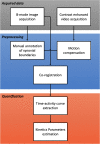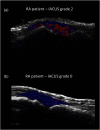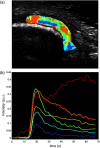Pixel-based approach to assess contrast-enhanced ultrasound kinetics parameters for differential diagnosis of rheumatoid arthritis
- PMID: 27014713
- PMCID: PMC4797088
- DOI: 10.1117/1.JMI.2.3.034503
Pixel-based approach to assess contrast-enhanced ultrasound kinetics parameters for differential diagnosis of rheumatoid arthritis
Abstract
Inflammatory rheumatic diseases are the leading causes of disability and constitute a frequent medical disorder, leading to inability to work, high comorbidity, and increased mortality. The standard for diagnosing and differentiating arthritis is based on clinical examination, laboratory exams, and imaging findings, such as synovitis, bone edema, or joint erosions. Contrast-enhanced ultrasound (CEUS) examination of the small joints is emerging as a sensitive tool for assessing vascularization and disease activity. Quantitative assessment is mostly performed at the region of interest level, where the mean intensity curve is fitted with an exponential function. We showed that using a more physiologically motivated perfusion curve, and by estimating the kinetic parameters separately pixel by pixel, the quantitative information gathered is able to more effectively characterize the different perfusion patterns. In particular, we demonstrated that a random forest classifier based on pixelwise quantification of the kinetic contrast agent perfusion features can discriminate rheumatoid arthritis from different arthritis forms (psoriatic arthritis, spondyloarthritis, and arthritis in connective tissue disease) with an average accuracy of 97%. On the contrary, clinical evaluation (DAS28), semiquantitative CEUS assessment, serological markers, or region-based parameters do not allow such a high diagnostic accuracy.
Keywords: arthritis; contrast enhanced ultrasound; kinetics analysis; parameter estimation; perfusion analysis.
Figures







Similar articles
-
Quantitative imaging by pixel-based contrast-enhanced ultrasound reveals a linear relationship between synovial vascular perfusion and the recruitment of pathogenic IL-17A-F+IL-23+ CD161+ CD4+ T helper cells in psoriatic arthritis joints.Clin Rheumatol. 2017 Feb;36(2):391-399. doi: 10.1007/s10067-016-3500-x. Epub 2016 Dec 20. Clin Rheumatol. 2017. PMID: 27995384
-
Vascular perfusion kinetics by contrast-enhanced ultrasound are related to synovial microvascularity in the joints of psoriatic arthritis.Clin Rheumatol. 2015 Nov;34(11):1903-12. doi: 10.1007/s10067-015-2894-1. Epub 2015 Feb 14. Clin Rheumatol. 2015. PMID: 25681071
-
Do ankle, hindfoot, and heel ultrasound findings predict the symptomatology and quality of life in rheumatoid arthritis patients?J Ultrason. 2020;20(81):e70-e82. doi: 10.15557/JoU.2020.0012. Epub 2020 Jun 15. J Ultrason. 2020. PMID: 32609963 Free PMC article.
-
Value of contrast-enhanced ultrasound in rheumatoid arthritis.Eur J Radiol. 2007 Nov;64(2):222-30. doi: 10.1016/j.ejrad.2007.07.011. Epub 2007 Sep 4. Eur J Radiol. 2007. PMID: 17768022 Review.
-
Contrast-enhanced ultrasonography in inflammatory arthritis.Med Ultrason. 2011 Sep;13(3):220-7. Med Ultrason. 2011. PMID: 21894293 Review.
Cited by
-
Update of Contrast-enhanced Ultrasound in Musculoskeletal Medicine: Clinical Perspectives - A Review.J Med Ultrasound. 2023 Jan 13;31(2):92-100. doi: 10.4103/jmu.jmu_94_22. eCollection 2023 Apr-Jun. J Med Ultrasound. 2023. PMID: 37576422 Free PMC article. Review.
-
Biomarkers for Musculoskeletal Pain Conditions: Use of Brain Imaging and Machine Learning.Curr Rheumatol Rep. 2017 Jan;19(1):5. doi: 10.1007/s11926-017-0629-9. Curr Rheumatol Rep. 2017. PMID: 28144827 Free PMC article. Review.
-
Role of Contrast-enhanced Ultrasound in the Evaluation of Inflammatory Arthritis.Chin Med J (Engl). 2017 Jul 20;130(14):1722-1730. doi: 10.4103/0366-6999.209885. Chin Med J (Engl). 2017. PMID: 28685724 Free PMC article. Review.
-
Image-Guided Cardiac Regeneration via a 3D Bioprinted Vascular Patch with Built-in CT Visibility.Chem Eng J. 2025 Sep 15;520:165926. doi: 10.1016/j.cej.2025.165926. Epub 2025 Jul 12. Chem Eng J. 2025. PMID: 40831601
-
Ultrasound Imaging in Psoriatic Arthritis: What Have We Learnt in the Last Five Years?Front Med (Lausanne). 2020 Aug 25;7:487. doi: 10.3389/fmed.2020.00487. eCollection 2020. Front Med (Lausanne). 2020. PMID: 32984374 Free PMC article. Review.

